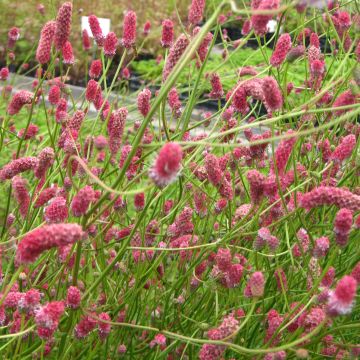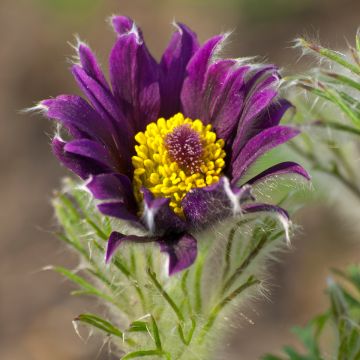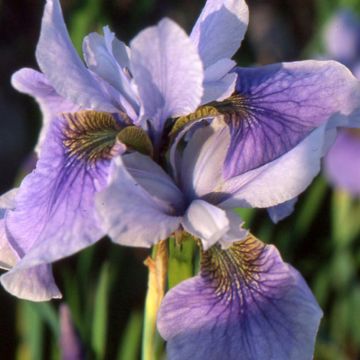

Sanguisorba canadensis


Sanguisorba canadensis


Sanguisorba canadensis
Sanguisorba canadensis
Sanguisorba canadensis
Pimprenelle du Canada, Sanguisorbe du Canada
and well this one never grows any leaves... maybe it arrived too weakened from the winter or died, the other two varieties are already doing great...
Carlos, 16/04/2020
Special offer!
Receive a €20 voucher for any order over €90 (excluding delivery costs, credit notes, and plastic-free options)!
1- Add your favorite plants to your cart.
2- Once you have reached €90, confirm your order (you can even choose the delivery date!).
3- As soon as your order is shipped, you will receive an email containing your voucher code, valid for 3 months (90 days).
Your voucher is unique and can only be used once, for any order with a minimum value of €20, excluding delivery costs.
Can be combined with other current offers, non-divisible and non-refundable.
Home or relay delivery (depending on size and destination)
Schedule delivery date,
and select date in basket
This plant carries a 12 months recovery warranty
More information
We guarantee the quality of our plants for a full growing cycle, and will replace at our expense any plant that fails to recover under normal climatic and planting conditions.
Would this plant suit my garden?
Set up your Plantfit profile →
Description
Sanguisorba candensis is a tall and beautiful burnet originating from North America. This robust perennial of wet places erects tall, fusiform spikes throughout the summer, reaching a height of 2 metres (7 feet), covered with white and frothy flowers. It is a giant but graceful wild plant, with finely cut foliage, almost exotic, forming a very green wide bouquet. Very hardy, it grows in any moist to wet soil, in a sunny or semi-shaded exposure. As such, this burnet is ideal for naturalizing a wet ditch or the edges of a pond, for example.
Sanguisorba canadensis, or Canadian burnet, is a rhizomatous perennial belonging to the vast family of Rosaceae. It is native to Canada, where it naturally grows in open spaces, in bogs, near swamps, not far from watercourses or in wet meadows. It is an herbaceous and rhizomatous perennial, weakly trailing, reaching 2 metres (7 feet) in height when in flower, 40cm (16in) for the foliage, and 80cm (32in) in spread. Flowering takes place from June-July to October, in the form of very small green and then white four-petal flowers, grouped in cylindrical 20cm (8in) long spikes, with a feathery appearance, carried by very tall and sturdy stems. The leaves are deciduous, odd-pinnate, alternate, composed of 7 to 17 petiolate leaflets, finely denticulate and dentate. The foliage colour is a bright green, softened by a fine down, and often turns red in autumn, at the first cold spells.
The Canadian burnet only requires constantly moist soil and enough sunlight to thrive. It will naturally find its place in a large massif with waterlogged soil, in the company of giant plants such as the lesser-known Datisca cannabina, Vernonias, Hosta 'Empress Wu', Artemisia lactiflora, Aruncus sinensis 'Zweiweltenkind', or Ligularia dentata 'Desdemona'. Also, place it near a pond, in groups of 3 plants, along with a Gunnera, royal fern, and Thalictrum 'Elin' for an exotic and natural-looking garden.
Etymology of Sanguisorba: comes from the Latin word SANGUIS which means blood and SORBERE to absorb, directly related to the hemostatic properties (which stop bleeding) of the roots used in herbal medicine.
Report an error about the product description
Sanguisorba canadensis in pictures




Flowering
Foliage
Plant habit
Botanical data
Sanguisorba
canadensis
Rosaceae
Pimprenelle du Canada, Sanguisorbe du Canada
North America
Other Sanguisorba
View all →Planting and care
Plant Sanguisorba canadensis in spring or autumn, maintaining an average planting distance of 80 centimetres (32 inches). To quickly create a beautiful effect, we recommend planting in groups of 3 to 5 plants. This young plant prefers moist to wet soils and a sunny to semi-shaded exposure. The soil should remain consistently moist. Being hardy, this burnet is not very demanding in terms of soil type, which can be either peaty (poor and acidic), humus-rich, or more clayey. It can withstand temperatures as low as -29°C (-20.2°F). Clumps can be easily divided in early spring. Prune the foliage after flowering, in autumn, as soon as it is no longer aesthetic.
Planting period
Intended location
Care
-
, onOrder confirmed
Reply from on Promesse de fleurs
Similar products
Haven't found what you were looking for?
Hardiness is the lowest winter temperature a plant can endure without suffering serious damage or even dying. However, hardiness is affected by location (a sheltered area, such as a patio), protection (winter cover) and soil type (hardiness is improved by well-drained soil).

Photo Sharing Terms & Conditions
In order to encourage gardeners to interact and share their experiences, Promesse de fleurs offers various media enabling content to be uploaded onto its Site - in particular via the ‘Photo sharing’ module.
The User agrees to refrain from:
- Posting any content that is illegal, prejudicial, insulting, racist, inciteful to hatred, revisionist, contrary to public decency, that infringes on privacy or on the privacy rights of third parties, in particular the publicity rights of persons and goods, intellectual property rights, or the right to privacy.
- Submitting content on behalf of a third party;
- Impersonate the identity of a third party and/or publish any personal information about a third party;
In general, the User undertakes to refrain from any unethical behaviour.
All Content (in particular text, comments, files, images, photos, videos, creative works, etc.), which may be subject to property or intellectual property rights, image or other private rights, shall remain the property of the User, subject to the limited rights granted by the terms of the licence granted by Promesse de fleurs as stated below. Users are at liberty to publish or not to publish such Content on the Site, notably via the ‘Photo Sharing’ facility, and accept that this Content shall be made public and freely accessible, notably on the Internet.
Users further acknowledge, undertake to have ,and guarantee that they hold all necessary rights and permissions to publish such material on the Site, in particular with regard to the legislation in force pertaining to any privacy, property, intellectual property, image, or contractual rights, or rights of any other nature. By publishing such Content on the Site, Users acknowledge accepting full liability as publishers of the Content within the meaning of the law, and grant Promesse de fleurs, free of charge, an inclusive, worldwide licence for the said Content for the entire duration of its publication, including all reproduction, representation, up/downloading, displaying, performing, transmission, and storage rights.
Users also grant permission for their name to be linked to the Content and accept that this link may not always be made available.
By engaging in posting material, Users consent to their Content becoming automatically accessible on the Internet, in particular on other sites and/or blogs and/or web pages of the Promesse de fleurs site, including in particular social pages and the Promesse de fleurs catalogue.
Users may secure the removal of entrusted content free of charge by issuing a simple request via our contact form.
The flowering period indicated on our website applies to countries and regions located in USDA zone 8 (France, the United Kingdom, Ireland, the Netherlands, etc.)
It will vary according to where you live:
- In zones 9 to 10 (Italy, Spain, Greece, etc.), flowering will occur about 2 to 4 weeks earlier.
- In zones 6 to 7 (Germany, Poland, Slovenia, and lower mountainous regions), flowering will be delayed by 2 to 3 weeks.
- In zone 5 (Central Europe, Scandinavia), blooming will be delayed by 3 to 5 weeks.
In temperate climates, pruning of spring-flowering shrubs (forsythia, spireas, etc.) should be done just after flowering.
Pruning of summer-flowering shrubs (Indian Lilac, Perovskia, etc.) can be done in winter or spring.
In cold regions as well as with frost-sensitive plants, avoid pruning too early when severe frosts may still occur.
The planting period indicated on our website applies to countries and regions located in USDA zone 8 (France, United Kingdom, Ireland, Netherlands).
It will vary according to where you live:
- In Mediterranean zones (Marseille, Madrid, Milan, etc.), autumn and winter are the best planting periods.
- In continental zones (Strasbourg, Munich, Vienna, etc.), delay planting by 2 to 3 weeks in spring and bring it forward by 2 to 4 weeks in autumn.
- In mountainous regions (the Alps, Pyrenees, Carpathians, etc.), it is best to plant in late spring (May-June) or late summer (August-September).
The harvesting period indicated on our website applies to countries and regions in USDA zone 8 (France, England, Ireland, the Netherlands).
In colder areas (Scandinavia, Poland, Austria...) fruit and vegetable harvests are likely to be delayed by 3-4 weeks.
In warmer areas (Italy, Spain, Greece, etc.), harvesting will probably take place earlier, depending on weather conditions.
The sowing periods indicated on our website apply to countries and regions within USDA Zone 8 (France, UK, Ireland, Netherlands).
In colder areas (Scandinavia, Poland, Austria...), delay any outdoor sowing by 3-4 weeks, or sow under glass.
In warmer climes (Italy, Spain, Greece, etc.), bring outdoor sowing forward by a few weeks.



















































